Do you have a question about the Panasonic Viera TX-L32U2B and is the answer not in the manual?
Accesses digital terrestrial broadcasts for viewing and programming.
Provides TV guide information for programme scheduling and selection.
Enables clear digital picture and high-quality sound via HDMI cable.
Plays photos and videos stored on an SD Card directly on the TV.
Supports AVCHD video format and SDXC cards for expanded storage.
Decodes Dolby Digital audio tracks for multi-channel sound output.
Facilitates easy control and integration of connected equipment.
Provides quick access to special features like VIERA Link and Media Player.
Helps identify the owner in case of theft by storing personal information.
Provides narration for visually-impaired viewers.
Warnings about electrical shock, fire, and damage from the power cord.
Details on the 5A fuse, its rating, and replacement procedure.
Avoid rain, moisture, heat, unstable surfaces, and foreign objects.
Warning about small parts (e.g., SD Card) and potential choking hazard for children.
Ensure adequate airflow and follow safe procedures for moving the TV.
Avoid hearing damage by not exposing ears to excessive headphone volume.
Lists included accessories (remote, batteries) and optional items (wall bracket).
Highlights risks and safety precautions for wall mounting the TV.
Provides instructions on how to replace batteries in the remote control.
Safety advice for assembling and securing the TV to the pedestal.
Instructions for assembling the pedestal components correctly.
Identifies buttons on the remote control and their primary functions.
Buttons for selecting functions, input modes, and power.
Explains the status indicated by the TV's LED light.
Automatically puts the TV into standby mode after a period of inactivity.
Instructions on how to use the remote to navigate menus and select items.
Diagrams illustrating connections for aerial, DVD/VCR, and other devices.
Important notes on connections, including HDMI, Q-Link, and SCART cables.
Diagram showing how to connect multiple external devices simultaneously.
Plug in the TV and start the auto setup for channel scanning.
Set up owner identification for security and personalization.
Choose between 'Home' mode for personal use and 'Shop' mode for display.
Procedure for setting PIN, name, house number, and postcode.
Explanation and selection of 'Shop' (demonstration) and 'Home' modes.
Powering on the TV and selecting DVB or Analogue input sources.
Methods for choosing TV channels using numeric buttons or TV Guide.
Viewing channel information and programme details via EPG.
Allows freezing and unfreezing the current TV picture.
Explains icons and messages displayed in the information banner.
Instructions on how to show or hide subtitles for programmes.
Adjusts the picture aspect ratio for optimal viewing.
Checking programme info, multi-audio, mono sound, and volume correction.
Quickly switches to the previously viewed channel or input mode.
Sets the TV to turn off automatically after a specified period.
Chooses the source (DVB or Analogue) for programme listings.
Instructions on how to access and use the Electronic Programme Guide.
Finds specific programmes by searching through categories or titles.
Sets timers for watching programmes or recording via external devices.
Uses EPG data to automatically set timers, adapting to schedule changes.
Accesses detailed information about programmes listed in the guide.
Displays advertisements related to programmes or upcoming content.
Introduction to digital teletext services and their features.
Instructions on using the remote control to interact with teletext content.
Important note regarding initial teletext software download and updates.
Explanation of analogue teletext, FASTEXT, and List modes.
Features for revealing hidden data and adjusting display layouts.
How to hold a teletext page without automatic updates.
Saving and accessing preferred teletext pages for quick retrieval.
Allows watching TV and teletext content simultaneously.
Methods for navigating and viewing specific sub-pages of teletext.
Allows viewing TV while teletext pages are being updated.
Powering on the TV and selecting external input modes.
How to display and select desired input modes from the menu.
Displays the currently selected input source on the screen.
Details on terminal connections, settings, and compatibility.
Using the TV remote to control connected external devices.
Procedure to change the remote control code for specific equipment.
Displaying feature icons and selecting a desired feature.
Instructions for using features like Link Control, Photo, and Video.
Steps to display, select, and adjust menu items.
Options for resetting picture, sound, or all settings to defaults.
Using the menu system to enter text for various settings.
Detailed settings for picture quality: Viewing Mode, Contrast, Colour, etc.
Detailed settings for audio: Mode, Bass, Treble, Equalizer, Surround.
Settings for volume correction, NICAM, Audio Description, and speakers.
Configuration for VIERA Link, Q-Link, and Standby Power Save.
Settings for DVB/Analogue tuning and Child Lock.
Manages channels: Channel List, Auto Setup, Manual Tuning.
Configures Input Labels, Banner Timeout, and Playing Time Display.
Controls Shipping Condition, Owner ID, and System Update.
Includes Postcode settings, Power Preference, and Auto Standby.
Visual overview of picture settings and their availability.
Visual overview of sound settings and their availability.
Overview of Setup menu sections and how to access them.
Details for Other, GUIDE Plus+, Display, Analogue Tuning, System Settings.
Details on connectivity features like VIERA Link and Q-Link.
Child lock settings and DVB channel management.
Analogue channel setup and favourite list management.
Automatic retuning of DVB channels to update the channel list.
Detailed steps for performing the automatic channel setup.
Using TV side panel buttons to initiate Auto Setup.
Automatic retuning of analogue channels to update the channel list.
Detailed steps for performing the automatic analogue channel setup.
Using TV side panel buttons to initiate analogue Auto Setup.
Accessing Auto Setup, Channel List, and Manual Tuning for DVB.
Organizes DVB channels by region or best signal quality.
Fine-tuning DVB channels by frequency for optimal reception.
Allows creation and management of up to four favourite channel lists.
Hides unwanted channels from the list or edits existing channels.
Automatically updates the channel list with new channels.
Sets up notifications for new DVB channels found.
Assesses signal quality (Good, Poor, Bad) for DVB reception.
Selecting Analogue tuning, menus, and channel list functions.
Hides unwanted analogue channels or edits existing channels.
Fine-tuning analogue channels manually for optimal reception.
Sets timers for watching programmes or recording via external devices.
Chooses the tuner source (DVB or Analogue) for timer programming.
Detailed steps for setting timers and important notes on their operation.
Sets function, channel, date, time, and subtitle recording.
Manages existing timer programming: editing, cancelling, or viewing.
Timer programming based on EPG data, adapting to schedule changes.
Locks channels/inputs and manages the PIN number for access.
View and manage the list of locked channels and inputs.
Names input terminals or skips them for easier selection.
Allows users to enter custom names for input terminals.
Restores the TV to its original factory condition, erasing all data.
Instructions for performing the factory reset procedure.
Entering PIN, name, address, and postcode for owner identification.
Procedure to change the Owner ID PIN number.
Inserting CI module and accessing its menu for conditional access.
Using instructions provided with the CI module for operation.
Methods for updating TV software automatically or immediately.
Steps for updating software and important notes on the process.
Accessing and viewing photo files stored on an SD card.
Different modes for viewing photos: one by one or as a slideshow.
Physical instructions for inserting and removing SD cards from the TV.
Settings for background music, frames, colour effects, and transitions.
Changing to video mode and sorting media files by folder or date.
Accessing and viewing video files (AVCHD, MPEG2) from an SD card.
How to play videos, select scenes, and operate playback controls.
Configuring audio output settings and SPDIF selection.
Settings for video playback, including overscan and preview.
Summary of connectivity features for controlling external equipment.
Specifics for SCART connection, including cable requirements.
Specifics for HDMI and HDMI/SCART connections.
Feature availability based on connected equipment (e.g., recorders, players).
Visual guides illustrating how to connect various equipment.
Managing multiple connected devices and their functionalities.
Steps for setting up and using Q-Link for device control.
Downloading analogue channel settings to a recorder.
Features for direct recording and synchronized power management.
Steps for setting up and using VIERA Link, including connection requirements.
Downloading channels and automatic input switching during playback.
Synchronized power control for connected equipment.
Uses Standby Power Save and Intelligent Auto Standby for energy efficiency.
Records programmes directly using the VIERA Link menu.
Records and plays back live TV programmes, pausing and resuming as needed.
How to access and use the Pause Live TV function.
Using the TV remote to control menus of connected devices.
Managing multiple recorders or players connected to the TV.
Controlling devices not supporting VIERA Link using their own remote.
Managing home theatre speakers and adjusting volume via TV remote.
Selecting sound output for Home Cinema or TV speakers.
Diagrams for connecting speakers, headphones, and DVD players.
Table indicating which terminals support various device types.
Diagrams for connecting camcorders, HDMI devices, and DVD recorders.
Diagrams for connecting satellite receivers and VCRs.
How auto aspect adjusts image size based on Widescreen signals.
How auto mode determines the best aspect ratio to fill the screen.
Precautions for handling SD cards and supported file formats.
Table for entering characters using numeric buttons in menus.
Detailed pin assignments for SCART and HDMI terminals.
Details on HDMI capabilities and DVI connection procedures.
Table showing supported signals for Component and HDMI inputs.
Supported PC signal formats compatible with HDMI input.
Solutions for block noise, frozen images, and channel tuning problems.
Solutions for missing image/sound and remote control malfunctions.
Problems related to Q-Link, VIERA Link, and recording functions.
Specific fixes for image, sound, and channel reception issues.
Solutions for power, remote control, and panel-related problems.
Understanding error messages and pixel behavior on the screen.
Explains various messages displayed on screen and the corresponding actions.
Definitions for technical terms like AVCHD, DVB, EPG, HDMI, JPEG, MPEG2, NICAM, NTSC, RF, SCART, SPDIF, VCR.
Instructions for regular cleaning of the TV's surfaces.
Care for the mains plug and details on product licensing.
Details on power consumption, screen size, pixels, and speakers.
Information on tuners, terminals, operating conditions, and physical size.
Information for customer support, service, and product inquiries.
Details for customer's record, purchase identification, and warranty service.
Accesses digital terrestrial broadcasts for viewing and programming.
Provides TV guide information for programme scheduling and selection.
Enables clear digital picture and high-quality sound via HDMI cable.
Plays photos and videos stored on an SD Card directly on the TV.
Supports AVCHD video format and SDXC cards for expanded storage.
Decodes Dolby Digital audio tracks for multi-channel sound output.
Facilitates easy control and integration of connected equipment.
Provides quick access to special features like VIERA Link and Media Player.
Helps identify the owner in case of theft by storing personal information.
Provides narration for visually-impaired viewers.
Warnings about electrical shock, fire, and damage from the power cord.
Details on the 5A fuse, its rating, and replacement procedure.
Avoid rain, moisture, heat, unstable surfaces, and foreign objects.
Warning about small parts (e.g., SD Card) and potential choking hazard for children.
Ensure adequate airflow and follow safe procedures for moving the TV.
Avoid hearing damage by not exposing ears to excessive headphone volume.
Lists included accessories (remote, batteries) and optional items (wall bracket).
Highlights risks and safety precautions for wall mounting the TV.
Provides instructions on how to replace batteries in the remote control.
Safety advice for assembling and securing the TV to the pedestal.
Instructions for assembling the pedestal components correctly.
Identifies buttons on the remote control and their primary functions.
Buttons for selecting functions, input modes, and power.
Explains the status indicated by the TV's LED light.
Automatically puts the TV into standby mode after a period of inactivity.
Instructions on how to use the remote to navigate menus and select items.
Diagrams illustrating connections for aerial, DVD/VCR, and other devices.
Important notes on connections, including HDMI, Q-Link, and SCART cables.
Diagram showing how to connect multiple external devices simultaneously.
Plug in the TV and start the auto setup for channel scanning.
Set up owner identification for security and personalization.
Choose between 'Home' mode for personal use and 'Shop' mode for display.
Procedure for setting PIN, name, house number, and postcode.
Explanation and selection of 'Shop' (demonstration) and 'Home' modes.
Powering on the TV and selecting DVB or Analogue input sources.
Methods for choosing TV channels using numeric buttons or TV Guide.
Viewing channel information and programme details via EPG.
Allows freezing and unfreezing the current TV picture.
Explains icons and messages displayed in the information banner.
Instructions on how to show or hide subtitles for programmes.
Adjusts the picture aspect ratio for optimal viewing.
Checking programme info, multi-audio, mono sound, and volume correction.
Quickly switches to the previously viewed channel or input mode.
Sets the TV to turn off automatically after a specified period.
Chooses the source (DVB or Analogue) for programme listings.
Instructions on how to access and use the Electronic Programme Guide.
Finds specific programmes by searching through categories or titles.
Sets timers for watching programmes or recording via external devices.
Uses EPG data to automatically set timers, adapting to schedule changes.
Accesses detailed information about programmes listed in the guide.
Displays advertisements related to programmes or upcoming content.
Introduction to digital teletext services and their features.
Instructions on using the remote control to interact with teletext content.
Important note regarding initial teletext software download and updates.
Explanation of analogue teletext, FASTEXT, and List modes.
Features for revealing hidden data and adjusting display layouts.
How to hold a teletext page without automatic updates.
Saving and accessing preferred teletext pages for quick retrieval.
Allows watching TV and teletext content simultaneously.
Methods for navigating and viewing specific sub-pages of teletext.
Allows viewing TV while teletext pages are being updated.
Powering on the TV and selecting external input modes.
How to display and select desired input modes from the menu.
Displays the currently selected input source on the screen.
Details on terminal connections, settings, and compatibility.
Using the TV remote to control connected external devices.
Procedure to change the remote control code for specific equipment.
Displaying feature icons and selecting a desired feature.
Instructions for using features like Link Control, Photo, and Video.
Steps to display, select, and adjust menu items.
Options for resetting picture, sound, or all settings to defaults.
Using the menu system to enter text for various settings.
Detailed settings for picture quality: Viewing Mode, Contrast, Colour, etc.
Detailed settings for audio: Mode, Bass, Treble, Equalizer, Surround.
Settings for volume correction, NICAM, Audio Description, and speakers.
Configuration for VIERA Link, Q-Link, and Standby Power Save.
Settings for DVB/Analogue tuning and Child Lock.
Manages channels: Channel List, Auto Setup, Manual Tuning.
Configures Input Labels, Banner Timeout, and Playing Time Display.
Controls Shipping Condition, Owner ID, and System Update.
Includes Postcode settings, Power Preference, and Auto Standby.
Visual overview of picture settings and their availability.
Visual overview of sound settings and their availability.
Overview of Setup menu sections and how to access them.
Details for Other, GUIDE Plus+, Display, Analogue Tuning, System Settings.
Details on connectivity features like VIERA Link and Q-Link.
Child lock settings and DVB channel management.
Analogue channel setup and favourite list management.
Automatic retuning of DVB channels to update the channel list.
Detailed steps for performing the automatic channel setup.
Using TV side panel buttons to initiate Auto Setup.
Automatic retuning of analogue channels to update the channel list.
Detailed steps for performing the automatic analogue channel setup.
Using TV side panel buttons to initiate analogue Auto Setup.
Accessing Auto Setup, Channel List, and Manual Tuning for DVB.
Organizes DVB channels by region or best signal quality.
Fine-tuning DVB channels by frequency for optimal reception.
Allows creation and management of up to four favourite channel lists.
Hides unwanted channels from the list or edits existing channels.
Automatically updates the channel list with new channels.
Sets up notifications for new DVB channels found.
Assesses signal quality (Good, Poor, Bad) for DVB reception.
Selecting Analogue tuning, menus, and channel list functions.
Hides unwanted analogue channels or edits existing channels.
Fine-tuning analogue channels manually for optimal reception.
Sets timers for watching programmes or recording via external devices.
Chooses the tuner source (DVB or Analogue) for timer programming.
Detailed steps for setting timers and important notes on their operation.
Sets function, channel, date, time, and subtitle recording.
Manages existing timer programming: editing, cancelling, or viewing.
Timer programming based on EPG data, adapting to schedule changes.
Locks channels/inputs and manages the PIN number for access.
View and manage the list of locked channels and inputs.
Names input terminals or skips them for easier selection.
Allows users to enter custom names for input terminals.
Restores the TV to its original factory condition, erasing all data.
Instructions for performing the factory reset procedure.
Entering PIN, name, address, and postcode for owner identification.
Procedure to change the Owner ID PIN number.
Inserting CI module and accessing its menu for conditional access.
Using instructions provided with the CI module for operation.
Methods for updating TV software automatically or immediately.
Steps for updating software and important notes on the process.
Accessing and viewing photo files stored on an SD card.
Different modes for viewing photos: one by one or as a slideshow.
Physical instructions for inserting and removing SD cards from the TV.
Settings for background music, frames, colour effects, and transitions.
Changing to video mode and sorting media files by folder or date.
Accessing and viewing video files (AVCHD, MPEG2) from an SD card.
How to play videos, select scenes, and operate playback controls.
Configuring audio output settings and SPDIF selection.
Settings for video playback, including overscan and preview.
Summary of connectivity features for controlling external equipment.
Specifics for SCART connection, including cable requirements.
Specifics for HDMI and HDMI/SCART connections.
Feature availability based on connected equipment (e.g., recorders, players).
Visual guides illustrating how to connect various equipment.
Managing multiple connected devices and their functionalities.
Steps for setting up and using Q-Link for device control.
Downloading analogue channel settings to a recorder.
Features for direct recording and synchronized power management.
Steps for setting up and using VIERA Link, including connection requirements.
Downloading channels and automatic input switching during playback.
Synchronized power control for connected equipment.
Uses Standby Power Save and Intelligent Auto Standby for energy efficiency.
Records programmes directly using the VIERA Link menu.
Records and plays back live TV programmes, pausing and resuming as needed.
How to access and use the Pause Live TV function.
Using the TV remote to control menus of connected devices.
Managing multiple recorders or players connected to the TV.
Controlling devices not supporting VIERA Link using their own remote.
Managing home theatre speakers and adjusting volume via TV remote.
Selecting sound output for Home Cinema or TV speakers.
Diagrams for connecting speakers, headphones, and DVD players.
Table indicating which terminals support various device types.
Diagrams for connecting camcorders, HDMI devices, and DVD recorders.
Diagrams for connecting satellite receivers and VCRs.
How auto aspect adjusts image size based on Widescreen signals.
How auto mode determines the best aspect ratio to fill the screen.
Precautions for handling SD cards and supported file formats.
Table for entering characters using numeric buttons in menus.
Detailed pin assignments for SCART and HDMI terminals.
Details on HDMI capabilities and DVI connection procedures.
Table showing supported signals for Component and HDMI inputs.
Supported PC signal formats compatible with HDMI input.
Solutions for block noise, frozen images, and channel tuning problems.
Solutions for missing image/sound and remote control malfunctions.
Problems related to Q-Link, VIERA Link, and recording functions.
Specific fixes for image, sound, and channel reception issues.
Solutions for power, remote control, and panel-related problems.
Understanding error messages and pixel behavior on the screen.
Explains various messages displayed on screen and the corresponding actions.
Definitions for technical terms like AVCHD, DVB, EPG, HDMI, JPEG, MPEG2, NICAM, NTSC, RF, SCART, SPDIF, VCR.
Instructions for regular cleaning of the TV's surfaces.
Care for the mains plug and details on product licensing.
Details on power consumption, screen size, pixels, and speakers.
Information on tuners, terminals, operating conditions, and physical size.
Information for customer support, service, and product inquiries.
Details for customer's record, purchase identification, and warranty service.
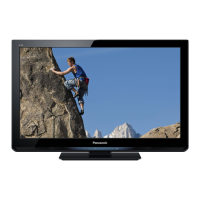
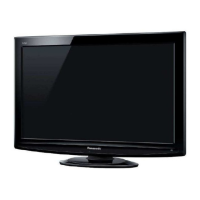
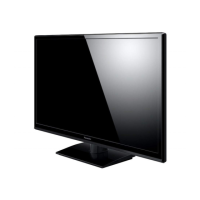

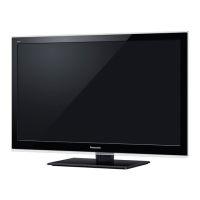
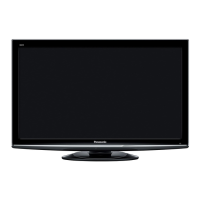


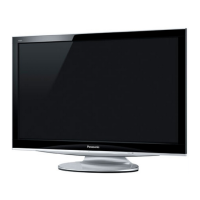
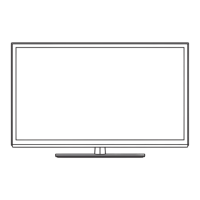
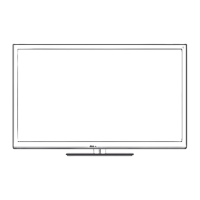

